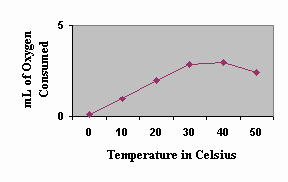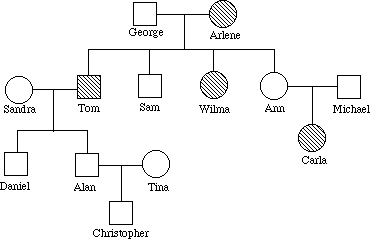| Lab 5 Cellular Respiration |
Introduction:
Cellular respiration is an ATP-producing catabolic process in which the ultimate electron acceptor is an inorganic molecule, such as oxygen. It is the release of energy from organic compounds by metabolic chemical oxidation in the mitochondria within each cell. Carbohydrates, proteins, and fats can all be metabolized as fuel, but cellular respiration is most often described as the oxidation of glucose, as follows:
C6H12O6 + 6O2 → 6CO2 + 6H2O + 686 kilocalories of energy/mole of glucose oxidized
Cellular respiration involves glycolysis, the Krebs cycle, and the electron transport chain. Glycolysis is a catabolic pathway that occurs in the cytosol and partially oxidizes glucose into two pyruvate (3-C). The Krebs cycle is also a catabolic pathway that occurs in the mitochondrial matrix and completes glucose oxidation by breaking down a pyruvate derivative (Acetyl-CoA) into carbon dioxide. These two cycles both produce a small amount of ATP by substrate-level phosphorylation and NADH by transferring electrons from substrate to NAD+ (Krebs cycle also produces FADH2 by transferring electrons to FAD). The electron transport chain is located at the inner membrane of the mitochondrion, accepts energized electrons from reduced coenzymes that are harvested during glycolysis and Krebs cycle, and couples this exergonic slide of electrons to ATP synthesis or oxidative phosphorylation. This process produces 90% of the ATP.
Cells respond to changing metabolic needs by controlling reaction rates. Anabolic pathways are switched off when their products are in ample supply. The most common mechanism of control is feedback inhibition. Catabolic pathways, such as glycolysis and the Krebs cycle, are controlled by regulating enzyme activity at strategic points. A key control point of catabolism is the third step of glycolysis, which is catalyzed by an allosteric enzyme, phosphofructokinase. The ratio of ATP to ADP and AMP reflects the energy status of the cell, and phosphofructokinase is sensitive to changes in this ratio. Citrate and ATP are allosteric inhibitors of phosphofructokinase, so when their concentration rise, the enzyme slows glycolysis. As the rate of glycolysis slows, the Krebs cycle also slows since the supply of Acetyl-CoA is reduced. This synchronizes the rates of glycolysis and the Krebs cycle. ADP and AMP are allosteric activators for phosphofructokinase, so when their concentrations relative to ATP rise, the enzyme speeds up glycolysis, which speeds of the Krebs cycle.
Cellular respiration is measure in three manners: the consumption of O2 (how many moles of O2 are consumed in cellular respiration?), production of CO2 (how many moles of CO2 are produced in cellular respiration?), and the release of energy during cellular respiration.
PV = nRT is the formula for the inert gas law, where P is the pressure of the gas, V is the volume of the gas, n is the number of molecules of gas, R is the gas constant, and T is the temperature of the gas in degrees K. This law implies several important things about gases. If temperature and pressure are kept constant then the volume of the gas is directly proportional to the number of molecules of the gas. If the temperature and volume remain constant, then the pressure of the gas changes in direct proportion to the number of molecules of gas. If the number of gas molecules and the temperature remain constant, then the pressure is inversely proportional to the volume. If the temperature changes and the number of gas molecules is kept constant, then either pressure or volume or both will change in direct proportion to the temperature.
Hypothesis:
The respirometer with only germinating peas will consume the largest amount of oxygen and will convert the largest amount of CO2 into K2CO3 than the respirometers with beads and dry peas and with beads alone. The temperature of the water baths directly effects the rate of oxygen consumption by the contents in the respirometers (the higher the temperature, the higher the rate of consumption).
Materials:
The following materials are necessary for the lab: 2 thermometers, 2 shallow baths, tap water, ice, paper towels, masking tape, germinating peas, non-germinating (dry) peas, glass beads, 100 mL graduated cylinder, 6 vials, 6 rubber stoppers, absorbent and non- absorbent cotton, KOH, a 5-mL pipette, silicon glue, paper, pencil, a timer, and 6 washers.
Methods:
Prepare a room temperature and a 10oC water bath. Time to adjust the temperature of each bath will be necessary. Add ice cubes to one bath until the desired temperature of 10oC is obtained.
Fill a 100 mL graduated cylinder with 50 mL of water. Add 25 germinating peas and determine the amount of water that is displaced. Record this volume of the 25 germinating peas, then remove the peas and place them on a paper towel. They will be used for respirometer 1. Next, refill the graduated cylinder with 50 mL of water and add 25 non-germinating peas to it. Add glass beads to the graduated cylinder until the volume is equivalent to that of the expanded germinating peas. Remove the beads and peas and place on a paper towel. They will be used in respirometer 2. Now, refill the graduated cylinder with 50 mL of water. Determine how many glass beads would be required to attain a volume that is equivalent to that of the germinating peas. Remove the beads. They will be used in respirometer 3. Then repeat the procedures used above to prepare a second set of germinating peas, dry peas and beads, and beads to be used in respirometers 4,5,and 6.
Assemble the six respirometers by obtaining 6 vials, each with an attached stopper and pipette. Then place a small wad of absorbent cotton in the bottom of each vial and, using the pipette or syringe, saturate the cotton with 15 % KOH. Be sure not to get the KOH on the sides of the respirometer. Then place a small wad of non-absorbent cotton on top of the KOH-soaked absorbent cotton. Repeat these steps to make the other five respirometers. It is important to use about the same amount of cotton and KOH in each vial.
Next, place the first set of germinating peas, dry peas and beads and beads alone in vials 1,2, and 3. Place the second set of germinating peas, dry peas and beads, and glass beads in vials 4,5, and 6. Insert the stoppers in each vial with the proper pipette. Place a washer on each of the pipettes to be used as a weight.
| Respirometer | Temperature | Contents |
| 1 | Room | Germinating Peas |
| 2 | Room | Dry Seeds + Beads |
| 3 | Room | Beads |
| 4 | 10oC | Germinating Peas |
| 5 | 10oC | Dry Seeds + Beads |
| 6 | 10oC | Beads |
Make a sling using masking tape and attach it to each side of the water baths to hold the pipettes out of the water during the equilibration period of 10 minutes. Vials 1,2, and 3 should be in the bath containing water at room temperature. Vials 4, 5, and 6 should be in the bath containing water that is 10oC. After the equilibration period, immerse all six respirometers into the water completely. Water will enter the pipette for a short distance and stop. If the water does not stop, there is a leak. Make sure the pipettes are facing a direction from where you can read them. The vials should not be shifted during the experiment and your hands should not be placed in the water during the experiment.
Allow the respirometers to equilibrate for three more minutes and then record the initial water reading in each pipette at time 0. Check the temperature in both baths and record the data. Every five minutes for 20 minutes take readings of the water’s position in each pipette, and record.
Results:
Table 1: Measurement of O2 Consumption by Soaked and Dry Pea Seeds at Room Temperature and 10˚C Using Volumetric Methods
|
Beads Alone |
Germinating Peas |
Dry Peas and Beads |
|||||||||||||||
|
Reading at time X |
Diff. |
Reading at time X |
Diff. |
Corrected Diff.∆ |
Reading at time X |
Diff. |
Corrected Diff.∆ |
||||||||||
|
Initial-0 |
1.38 | 1.35 | 1.47 | ||||||||||||||
|
0-5 |
1.38 | 0 | 1.16 | .19 | .19 | 1.46 | .01 | .01 | |||||||||
|
5-10 |
1.38 | 0 | 1.04 | .31 | .31 | 1.44 | .03 | .03 | |||||||||
|
10-15 |
1.38 | 0 | 0.93 | .42 | .42 | 1.43 | .04 | .04 | |||||||||
|
15-20 |
1.38 | 0 | 0.57 | .78 | .78 | 1.42 | .05 | .05 | |||||||||
|
Initial-0 |
1.40 | 1.32 | 1.40 | ||||||||||||||
|
0-5 |
1.39 | .01 | 1.20 | .12 | .11 | 1.40 | 0 | .01 | |||||||||
|
5-10 |
1.38 | .02 | 1.11 | .21 | .19 | 1.40 | 0 | .02 | |||||||||
|
10-15 |
1.38 | .02 | 1.00 | .32 | .30 | 1.39 | .01 | .01 | |||||||||
|
15-20 |
1.38 | .02 | 0.95 | .37 | .93 | 1.38 | .02 | 0 | |||||||||
In this activity, you are investigating both the effects of germination versus non-germination and warm temperature versus cold temperature on respiration rate. Identify the hypothesis being tested on this activity. The rate of cellular respiration is higher in the germinating peas in cold than in the beads or non-germinating peas; the cooler temperature in the cold water baths slows the process of cellular respiration in the both germinating and non-germinating peas.

This activity uses a number of controls. Identify at least three of the controls, and describe the purpose of each. The constant temperature in the water baths yielding stable readings, the unvarying volume of KOH from vial to vial leading to equal amounts of carbon dioxide consumption, identical equilibration periods for all the respirometers, precise time intervals between measurements, and glass beads acting as a control for barometric pressure all served as controls.
Describe and explain the relationship between the amount of oxygen consumed and time. There was a constant, gradual incline in the amount of oxygen consumed over precise passage of time.
|
Condition |
Calculations |
Rate in mL O2/ minute |
|
Germinating Peas/ 10 oC
|
(1.40-1.38)
20 min. |
.001 |
|
Germinating Peas/ 20 oC
|
(1.35-.57)
20 min. |
.040 |
|
Dry Peas/ 10 oC
|
(1.40-1.38)
20 min. |
.001 |
|
Dry Peas/ 20 oC |
(1.47-1.42)
20 min. |
.003 |
Why is it necessary to correct the readings from the peas with the readings from the beads? The beads served as a control variable, therefore, the beads experienced no change in gas volume.
Explain the effects of germination (versus non-germination) on pea seed respiration. The germinating seeds have a higher metabolic rate and needed more oxygen for growth and survival. The non-germinating peas, though alive, needed to consume far less oxygen for continued subsistence.

Above is a sample graph of possible data obtained for oxygen consumption by germinating peas up to about 8 oC. Draw in predicted results through 45 oC. Explain your prediction. Once the temperature reached a certain point, the enzymes necessary for cellular respiration denatured and germination (and large amounts of oxygen consumption) was inhibited.
What is the purpose of KOH in this experiment? The KOH drops absorbed the carbon dioxide and caused it to precipitate at the bottom of the vial and no longer able to effect the readings.
Why did the vial have to be completely sealed under the stopper? The stopper at the top of the vial had to be completely sealed so that no gas could leak out of the vial and no water would be allowed into the vial.
If you used the same experimental design to compare the rates of respiration of a 35g mammal at 10 oC, what results would you expect? Explain your reasoning. Respiration would be higher in the mammal since they are warm-blooded and endothermic.
If respiration in a small mammal were studied at both room temperature (21 oC) and 10 oC, what results would you predict? Explain your reasoning. Respiration would be higher at 21 degrees because it would be necessary for the animal to maintain a higher body temperature. The results would proliferate at 10 degrees because the mammal would be required to retain its body temperature at an even lower temperature in comparison to room temperature.
Explain why water moved into the respirometer pipettes. While the peas underwent cellular respiration, they consumed oxygen and released carbon dioxide, which reacted with the KOH in the vial, resulting in a decrease of gas in the pipette. The water moved into the pipette because the vial and pipette were completely submerged into the bath.
Design an experiment to examine the rates of cellular respiration in peas that have been germinating for 0, 24, 48, and 72 hours. What results would you expect? Why? Respirometers could be set up with respirometer 1 containing non-germinating peas, respirometer 2 holding peas that have been germinating 24 hours, 3 would contain the peas that germinated 48 hours, and 4 would hold the peas that germinated 72 hours. All the respirometers should have the KOH added to the bottom in the same manner as in lab described earlier. The respirometers should be placed in baths with the same temperature for all the respirometers. The seeds that have not begun germination would consume very little oxygen. The peas that have been germinating for 72 hours will have the greatest amount of oxygen consumption, while the other two samples will consume a medium (in comparison to respirometers 1 and 4 results) amount of oxygen.
Error Analysis:
Numerous errors could have occurred throughout the lab. The temperature of the baths may have been allowed to fluctuate, the amounts of peas, beads, KOH, and cotton may have varied from vial to vial damaging the results, and these problems would have occurred only during set up. Air may have been allowed to creep into the vial via a leaky stopper or poorly sealed pipette. Timing for the equilibration of the respirometers and the five-minute time intervals may have been erroneous. It was somewhat difficult to read the markings on the pipettes and so errors are always likely. Mathematical inaccuracies may have taken place when filling out the table and finding the corrected difference by using the formula provided.
Discussion and Conclusion:
The lab and the results gained from this lab demonstrated many important things relating to cellular respiration. It showed that the rates of cellular respiration are greater in germinating peas than in non-germinating peas. It also showed that temperature and respiration rates are directly proportional; as temperature increases, respiration rates increase as well. Because of this fact, the peas contained by the respirometers placed in the water at 10 oC carried on cellular respiration at a lower rate than the peas in respirometers placed in the room temperature water. The non-germinating peas consumed far less oxygen than the germinating peas. This is because, though germinating and non-germinating peas are both alive, germinating peas require a larger amount of oxygen to be consumed so that the seed will continue to grow and survive.
In the lab, CO2 made during cellular respiration was removed by the potassium hydroxide (KOH) and created potassium carbonate (K2CO3). It was necessary that the carbon dioxide be removed so that the change in the volume of gas in the respirometer was directly proportional to the amount of oxygen that was consumed. In the experiment water will moved toward the region of lower pressure. During respiration, oxygen will be consumed and its volume will be reduced to a solid. The result was a decrease in gas volume within the tube, and a related decrease in pressure in the tube. The respirometer with just the glass beads served as a control, allowing changes in volume due to changes in atmospheric pressure and/or temperature.



![Structure of alanine. [str5ala.jpg]](https://biologyjunction.com/images/str5ala.jpg)
![Structure of arginine. [str5arg.jpg]](https://biologyjunction.com/images/str5arg.jpg)
![Structure of asparagine. [str5asn.jpg]](https://biologyjunction.com/images/str5asn.jpg)
![Structure of aspartic acid. [str5asp.jpg]](https://biologyjunction.com/images/str5asp.jpg)
![Structure of cysteine. [str5cys.jpg]](https://biologyjunction.com/images/str5cys.jpg)
![Structure of glutamic acid. [str5glu.jpg]](https://biologyjunction.com/images/str5glu.jpg)
![Structure of glutamine. [str5gln.jpg]](https://biologyjunction.com/images/str5gln.jpg)
![Structure of glycine. [str5gly.jpg]](https://biologyjunction.com/images/str5gly.jpg)
![Structure of histidine. [str5his.jpg]](https://biologyjunction.com/images/str5his.jpg)
![Structure of isoleucine. [str5ile.jpg]](https://biologyjunction.com/images/str5ile.jpg)
![Structure of leucine. [str5leu.jpg]](https://biologyjunction.com/images/str5leu.jpg)
![Structure of lysine. [str5lys.jpg]](https://biologyjunction.com/images/str5lys.jpg)
![Structure of methionine. [str5met.jpg]](https://biologyjunction.com/images/str5met.jpg)
![Structure of phenylalanine. [str5phe.jpg]](https://biologyjunction.com/images/str5phe.jpg)
![Structure of proline. [str5pro.jpg]](https://biologyjunction.com/images/str5pro.jpg)
![Structure of serine. [str5ser.jpg]](https://biologyjunction.com/images/str5ser.jpg)
![Structure of threonine. [str5thr.jpg]](https://biologyjunction.com/images/str5thr.jpg)
![Structure of tryptophan. [str5trp.jpg]](https://biologyjunction.com/images/str5trp.jpg)
![Structure of tyrosine. [str5tyr.jpg]](https://biologyjunction.com/images/str5tyr.jpg)
![Structure of valine. [str5val.jpg]](https://biologyjunction.com/images/str5val.jpg)
